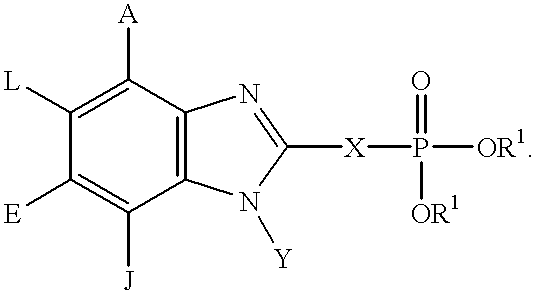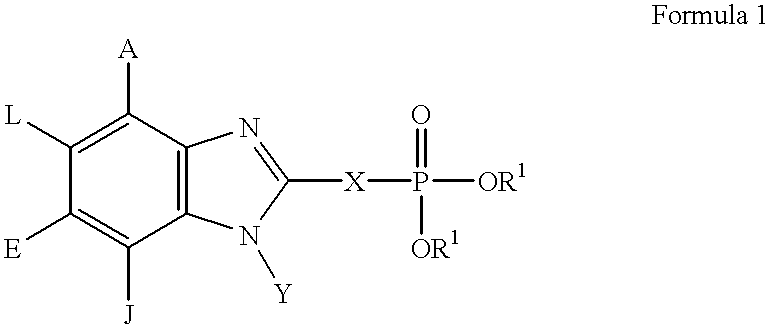Benzimidazole inhibitors of fructose 1,6-bisphosphatase
a technology of fructose 1, 6bisphosphatase and benzimidazole, which is applied in the direction of biocide, drug composition, metabolic disorder, etc., can solve the problems of limiting affecting the treatment effect, and affecting the overall success of the treatmen
- Summary
- Abstract
- Description
- Claims
- Application Information
AI Technical Summary
Benefits of technology
Problems solved by technology
Method used
Image
Examples
example 1
Preparation of 2-Furaldehyde-5-diethylphosphonate
Method A
To a solution of 25 mL (147.5 mmol) 2-furaldehyde diethyl acetal in 25 ml of THF at -78.degree. C., was added 96 mL (147.2 mmol) of a 1.6 M BuLi hexane solution. The solution was allowed to stir for 1 h at -78.degree. C. and 24 mL (166.1 mmol) chlorodiethylphosphonate was added and stirred for 0.5 h. The mixture was quenched at -78.degree. C. with a saturated NH.sub.4 Cl solution. The precipitates formed were filtered and the filtrate concentrated. The mixture was partitioned between water and CH.sub.2 Cl.sub.2 and separated. The organic layer was dried with sodium sulfate, filtered and the solvent removed under reduced pressure. The resulting brown oil was treated with 80% acetic acid and heated at 90.degree. C. for 4 h. Chromatography on silica using 75% ethyl acetate / hexanes yielded 9.1 g (39.2 mmol, 26.6%) of a clear oil.
Method B
To a solution of 2.8 mL (13.75 mmol) TMEDA and 1.0 mL (13.75 mmol) furan in 9 mL of diethyl eth...
example 2
Preparation of 5-diethylphosphono-2-thiophenecarboxaldehyde
Step 1
A solution of 1.0 mmol 2-thienyl lithium in THF was treated with 1.0 mmol diethyl chlorophosphate at -78.degree. C. for 1 h. Extraction and chromatography gave diethyl 2-thiophenephosphonate as a clear oil.
Step 2
A solution 1.0 mmol of diethyl 2-thiophenephosphonate in tetrahydrofuran was treated with 1.12 mmol LDA at -78.degree. C. for 20 min. 1.5 mmol methyl formate was added and the reaction was stirred for 1 hr. Extraction and chromotagraphy gave 5-diethylphosphono-2-thiophenecarboxaldehyde as a clear yellow oil.
example 3
General Methods for the Preparation of Substituted 1,2-phenylenediamines
Method A
Step 1
Bromination of Nitroanilines
To a solution of 1.0 mmol of sustituted nitroaniline in 10 mL of CHCl.sub.3 or a mixture of CHCl.sub.3 and MeOH (7:1) was added a solution containing one equivalent of Br.sub.2 in 5 mL of CHCl.sub.3 over a period of 30 min. After stirring for 2 days at room temperature, extractive isolation provided the bromination product.
Step 2
Reduction of Nitroanilines
To a solution of 1.0 mmol of substituted nitroaniline in 15 mL of MeOH was added 15 mL of saturated solution of sodium dithionite. Filtration followed by removal of solvent and extraction with EtOAc provided the pure diamine.
Step 3
Preparation of 2,1,3-benzoselenadiazole
To a solution of 1.0 mmol of substituted diamine in 3 mL of 50% aq. ethanol was added a solution of 1.0 mmol of SeO.sub.2 in 1.5 mL of H.sub.2 O. The mixture quickly thickened to a slurry. The solid separated out, was filtered, washed with water, and dried...
PUM
| Property | Measurement | Unit |
|---|---|---|
| temperature | aaaaa | aaaaa |
| temperature | aaaaa | aaaaa |
| temperature | aaaaa | aaaaa |
Abstract
Description
Claims
Application Information
 Login to View More
Login to View More - R&D
- Intellectual Property
- Life Sciences
- Materials
- Tech Scout
- Unparalleled Data Quality
- Higher Quality Content
- 60% Fewer Hallucinations
Browse by: Latest US Patents, China's latest patents, Technical Efficacy Thesaurus, Application Domain, Technology Topic, Popular Technical Reports.
© 2025 PatSnap. All rights reserved.Legal|Privacy policy|Modern Slavery Act Transparency Statement|Sitemap|About US| Contact US: help@patsnap.com



